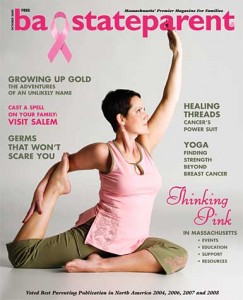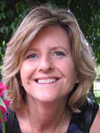Finding Strength Beyond Breast Cancer:
 How Rehabilitative Yoga Can Help
How Rehabilitative Yoga Can Help
By Trish Reske
Published in baystateparent magazine
When baystateparent’s Think Pink cover model, Jacy Watson, of Concord, MA was diagnosed with breast cancer at age 37, the very last thing on her mind was yoga.
“You get the phone call, and you’re sitting in your house, and the first thing you think is, ‘Oh my God’ and ‘What do I do?'”
What she did was begin a long journey of treatment for her breast cancer that included multiple surgeries, chemotherapy and radiation. When it was all over, she was given a booklet of recommended exercises to help ease pain and restore her range of motion.
The booklet was more than what a majority of women get after treatment. But it was not enough for Jacy, who was concerned that restricted arm mobility and shoulder strength might force her to abandon her profession as a cosmetologist.
Today, Jacy participates in Exclusive Yoga© rehabilitative classes for women living through—and beyond—breast cancer.
“It’s been almost a year since I’ve come here,” she says. “I go to my doctor’s appointments and they are amazed at my flexibility, amazed at my range of motion.”
Anne Bisson from Sudbury, MA was in a lot of pain after her lumpectomy in 2005. “After surgery I had terrible pain and range of motion. I was never given any exercises to do after surgery in terms of rehab. When I went to reach for something, it was terrible. I couldn’t even reach to get a plate,” she says.
She didn’t know what she wasn’t told: that even a few simple rehabilitative exercises, done post-surgery after her drains were removed, could have spared her so much lingering pain.
Weston, MA resident Mary Tanski, who had attended exercise classes since her twenties, recalls that after her lumpectomy ten years ago, her doctor simply said, ‘Just go about your regular activities.’
“She gave me one exercise where I crawled my arm up the wall. It was very painful after the surgery, very tender and sensitive for quite awhile. My range of motion was very small.”
These three woman eventually found their way to Camille Kittrell, owner of Exclusive Yoga in Waltham, MA.
A Unique Program for Breast Cancer Recovery
Over the past ten years, Camille has pioneered a unique program of rehabilitative yoga that meets the specific needs of breast cancer survivors at various stages of treatment and recovery.
Camille’s yoga routines restore upper body range of motion and flexibility and rebuild total body muscular strength —without poses or movements that may cause pain or incite lymphedema (abnormal swelling and pain in the arm after surgical removal of multiple lymph nodes and radiation during breast cancer treatment).
“It’s not just pure yoga moves,” Camille explains. “I draw on a lot of disciplines—like ballet, sports, Hatha yoga, stretching. It’s Camille Yoga,” she quips.
In fact, Camille stresses that traditionally, yoga was designed by men for young men.
“Some poses are not designed for women’s bodies, let alone women recovering from breast cancer,” she stresses.
Instead, her yoga classes provide women with more physical comfort and emotional equilibrium.
“I always start with a total body warm-up, so that will get the blood moving and you’re less prone to be hurt, and within that warm-up I do a lot of flowing movements to help increase range of motion, which will be lost often from surgeries, where muscle tissue has been removed and you simply cannot move your upper body,” she says.
Along with therapeutic back movement, core work, and standing poses, Camille often adds movements geared for a woman based on her specific medical history. She ends each class with soothing guided relaxation.
“The guided relaxation in the end of the class is meant to calm them. To take that, imprint it, and take it in to the rest of their day. That’s powerful,” she says.
Anne agrees. “I was not one to really relax. The days that I go, whatever happens the rest of the day, the relaxation—just that mindset— carries me through the day. As a mother, you don’t do many things for yourself. But that is one thing I do.” she says.
Mary, one of Camille’s first clients, had never taken yoga before breast cancer. Today, she sees so many benefits.
“I’m so much stronger. My mobility in my arm, which was giving me so much trouble over the years, is gone,” she says.
But the biggest benefit for Mary is the ability to not be afraid of cancer, which has loomed large in her family life. Her mother died from breast cancer at age 57. Mary and her daughters all have the BRCA genetic mutation. And Mary’s daughter was diagnosed with breast cancer just a few years ago, at age 37.
“I was very fearful because I was afraid I was going to have a recurrence,” she remembers. “When I got into yoga, the thing that helped me most was that it made me live in the moment. Doing the poses, and being in the moment made me be able to go out and be in the world again, and be relaxed and live my life,” she says.
A Critical, yet often Overlooked Component of Total Recovery
Camille’s passion to provide recovery-based yoga began over a decade ago, when long-time friend Jennifer Atkinson asked Camille, also her fitness instructor, to design an exercise and stretch routine to ease the discomfort she was experiencing after radiation, chemo, and multiple surgeries for breast cancer.
After extensive research at medical libraries, online, and through support groups, “I could find NOTHING, NADA, ZIP on rehab exercises for breast cancer survivors that would help their bodies recover from the physical trauma of treatment and surgery,” Camille says. “I was not just dismayed, but shocked at the oversight of our healthcare system.”
In 2002, Camille presented a “Gentle Yoga for Recovery & Beyond” workshop at the annual Celebration of Life event sponsored by Beth Israel-Deaconess Medical Center and Harvard Medical School. In 2003, she launched her studio in Waltham. Today, Camille continues to offer classes, as well as conduct intensive two-day workshops called Yoga for Breast Cancer Recovery & Beyond©. She has trained over 100 yoga instructors on breast cancer recovery and is currently pursuing a business partnership that will extend and promote her training nationwide.
“Women are given nothing or very little in terms of recovery exercises after surgery,” says Camille. “Even when women get post-surgery physical therapy, it’s usually only one or two appointments, plus a one-page handout with a few arm exercises. That’s not enough to adequately rehabilitate most survivors.”
Camille meets women all the time who either avoid physical exercise, or do too much too soon after treatment and end up injuring themselves. Her mission is to get the word out to doctors, personal trainers, fitness instructors and breast cancer survivors that physical rehabilitation is a critical, yet often overlooked component of total recovery from breast cancer.
Jacy agrees. “After treatment there’s not a lot of ‘How do I live with this body when I’m done? How do I deal with the different things that treatment has done to my body?’ You have a heart attack, there’s cardiac rehab. You have a hip replacement, you get rehabilitation. You have your breasts removed and it’s, ‘Oh well, see ya.’ And that’s something that has to change,” she says.
Anne agrees. “You’re cared for by a team of doctors all during your treatment, and then you go to your last appointment and you’re alone. And that’s daunting,” she says. “To know there was a place to go (Exclusive Yoga), it was incredible.”
These women agree with Camille that breast cancer survivors need to have a collective voice, to raise awareness of the need for rehabilitative programs.
“Millions of people will go on walks or run to find a cure. Why don’t all the survivors speak up and say ‘We need a kind of program that helps us find more comfort in our bodies beyond a page or two of physical therapy exercises?'” Camille asks.
“Wouldn’t it be great if an organization saw the need to create a nationalized, multi-level rehab program for women who have gone through breast cancer? Because what you need initially is different than what you need a year later, and that may be different two years later. You can’t just do a few exercises on a sheet of paper two years from recovery and find total body comfort. You need to do more, you need to have a variety and you need to do it on a regular basis,” she says.
Jacy’s journey with breast cancer is not over yet. She will undergo additional reconstruction surgeries beginning in January 2010. But this time she plans to include yoga as a key part of her recovery.
“This is where yoga with Camille will prove —I believe—to be my lifesaver,” she says. “I look forward to her help through my next series of surgery. She is a well-trained instructor but also a very caring new friend.”
For information on Exclusive Yoga or Camille’s DVD. “Gentle Yoga for Recovery & Beyond,” visit exclusiveyoga.com.
 My professional experience includes leading the creative efforts of three companies I have co-owned. I'm a seasoned copywriter/creative director, award-winning journalist, avid runner, and mom of four. Got a story idea you'd like to share? Email me at treske@nowspeed.com. You can also find me on Twitter: @trishreske, LinkedIn and Facebook.
My professional experience includes leading the creative efforts of three companies I have co-owned. I'm a seasoned copywriter/creative director, award-winning journalist, avid runner, and mom of four. Got a story idea you'd like to share? Email me at treske@nowspeed.com. You can also find me on Twitter: @trishreske, LinkedIn and Facebook.